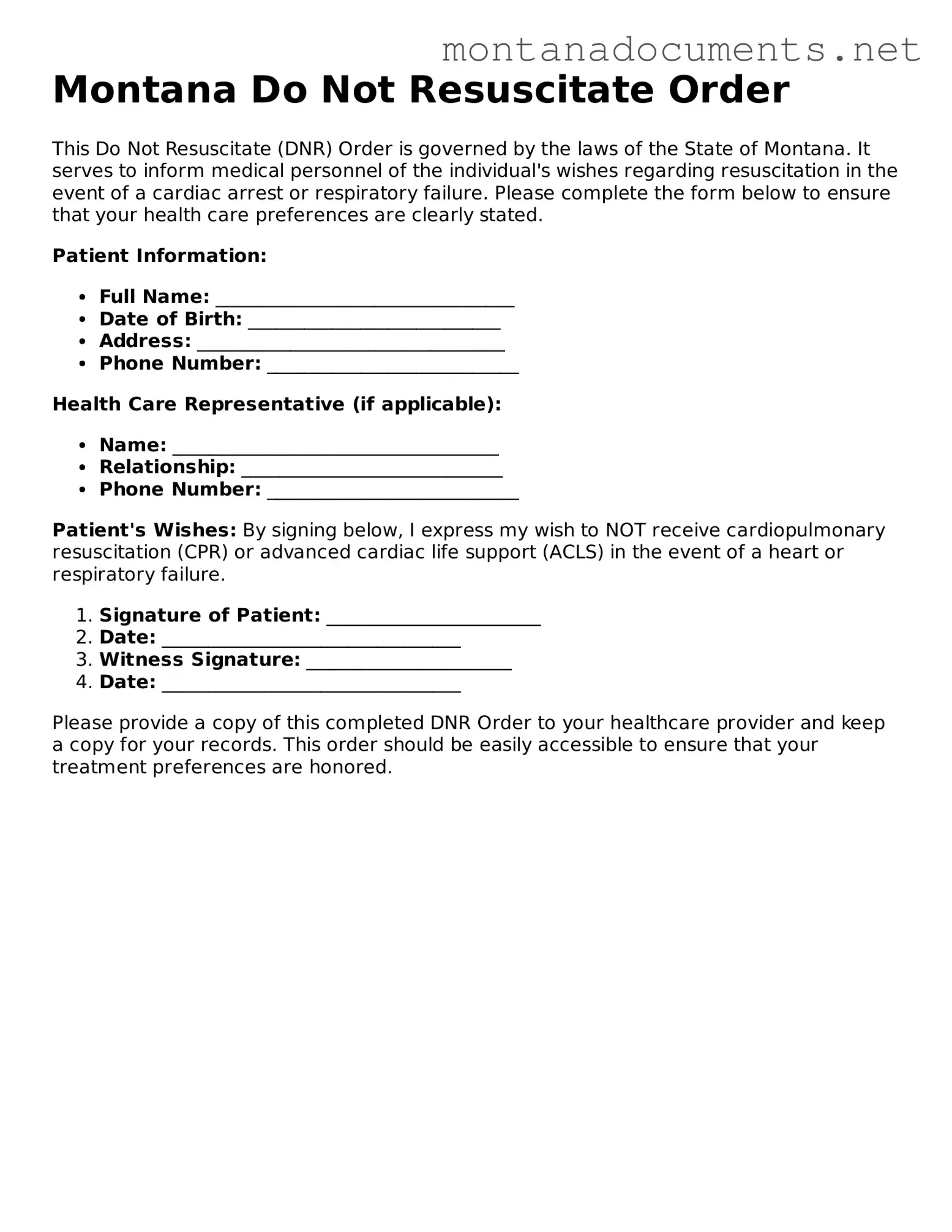The Montana Do Not Resuscitate (DNR) Order form shares similarities with the Advance Directive, a legal document that outlines a person's wishes regarding medical treatment in the event they become unable to communicate. Both documents serve to ensure that an individual's preferences are respected during critical health situations. An Advance Directive can include a variety of instructions, such as preferences for life-sustaining treatments, and may also appoint a healthcare proxy to make decisions on behalf of the individual. This empowers individuals to have a say in their medical care, much like the DNR does specifically regarding resuscitation efforts.
Another document akin to the DNR Order is the Physician Orders for Life-Sustaining Treatment (POLST). This form is designed for patients with serious illnesses and translates their treatment preferences into actionable medical orders. Just as the DNR specifies a patient’s desire not to receive cardiopulmonary resuscitation (CPR), the POLST allows individuals to express their wishes regarding a broader range of life-sustaining treatments. Both documents require a healthcare professional’s signature, ensuring that the patient’s wishes are documented and respected by medical personnel.
The Living Will is another document that bears resemblance to the Montana DNR Order. A Living Will allows individuals to outline their preferences for medical care in situations where they may be incapacitated. While the DNR focuses specifically on resuscitation efforts, a Living Will can cover various aspects of end-of-life care, including preferences for pain management and other life-sustaining measures. Both documents aim to communicate the patient’s wishes clearly, thereby minimizing confusion for healthcare providers and family members during critical moments.
Similar to the DNR Order, the Medical Power of Attorney grants a designated person the authority to make medical decisions on behalf of someone else. This document comes into play when the individual is unable to express their wishes. While the DNR specifically addresses resuscitation, the Medical Power of Attorney encompasses a broader range of medical decisions. Both documents emphasize the importance of having a clear plan in place to ensure that healthcare decisions align with the individual's values and preferences.
The Healthcare Proxy is another document that parallels the DNR Order. It designates a trusted individual to make healthcare decisions on behalf of someone who is unable to do so. Like the DNR, which provides specific instructions regarding resuscitation, a Healthcare Proxy allows the appointed person to interpret the individual's wishes and make decisions in line with those preferences. Both documents serve to protect patient autonomy and ensure that care aligns with the individual’s desires.
In many legal proceedings, the submission of various forms is essential, including those that affirm the delivery of documents. A noteworthy example is the Affidavit of Service form, which verifies the proper serving of legal papers, an integral step in the judicial process. Just as other documents delineate preferences in healthcare decisions, the Affidavit of Service encapsulates a critical declaration that supports the integrity and progression of legal actions.
The Comfort Care Order, while not as widely recognized, shares similarities with the DNR Order in that it focuses on the quality of life rather than aggressive medical interventions. This document outlines the desire for comfort measures only, without the use of life-sustaining treatments. Like the DNR, it emphasizes the importance of patient comfort and dignity in end-of-life care, ensuring that healthcare providers understand the individual’s priorities during critical health situations.
The Do Not Intubate (DNI) Order is another document that is closely related to the DNR Order. A DNI specifies that a patient does not wish to be placed on a ventilator if they are unable to breathe on their own. While the DNR addresses resuscitation efforts more broadly, the DNI focuses specifically on the use of mechanical ventilation. Both documents reflect the patient’s wishes regarding interventions that may prolong life but do not necessarily improve its quality.
The End-of-Life Care Plan can also be likened to the DNR Order. This comprehensive document outlines an individual’s preferences for all aspects of care at the end of life, including pain management, resuscitation, and emotional support. While the DNR focuses solely on resuscitation, the End-of-Life Care Plan provides a more holistic view of the individual's desires, ensuring that all aspects of their care align with their values and wishes.
Finally, the Hospice Care Plan shares similarities with the DNR Order in that both documents prioritize comfort and quality of life for patients with terminal conditions. The Hospice Care Plan outlines specific goals for care, focusing on symptom management and emotional support rather than curative treatments. In this way, both documents reflect a shift in focus from aggressive medical interventions to a more compassionate approach to end-of-life care.
